
Overcoming Electric Vehicle Resistance: The 2023 VW ID.4 Comprehensive Review

Overcoming Electric Vehicle Resistance: The 2023 VW ID.4 Comprehensive Review
Quick Links
- ID.4 Price, Model, and Availability
- Exterior Design: The Look of a Familiar SUV
- Interior Design: Simple, Yet Comfortable
- Range Plus Anxiety
- Driving the 2023 ID.4: Coasting Is In
- Infotainment and Technology, or a Lack Thereof
- Should You Buy the 2023 VVW ID.4?
Key Takeaways
- The VW ID.4 is a familiar choice for first-time EV buyers seeking a modern-looking SUV with a comfortable interior.
- It lacks front trunk storage space, good one-pedal driving, and has poor tech integration with the myVW mobile app.
- The charging experience can be frustrating, but the ID.4 offers a decent driving experience with peppy acceleration and IQ.Drive safety features.
The VW ID.4 is a modern-looking SUV, but if you didn’t know it was all electric, nothing about its exterior (or interior) jumps out as being an EV. The ID.4 plays it safe in nearly every regard. Some people will call it boring. For others, however, it might just be familiar enough to take a chance on and switch their fuel from gasoline to electric power.
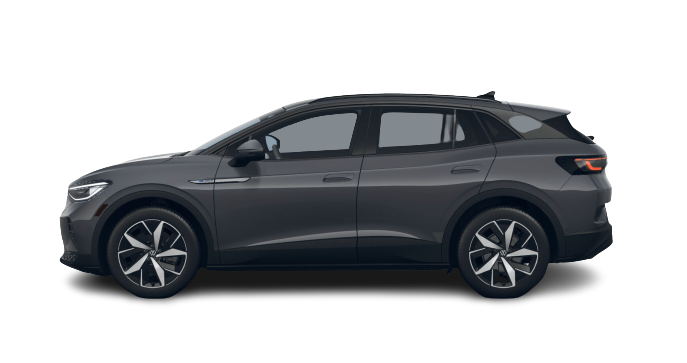
2023 Volkswagen ID.4
7/ 10
The all-electric 2023 ID.4 is an SUV through and through, offering a spacious, modern cabin built for drivers and passengers alike along with sporty, streamlined looks.
Model
AWS Pro S
Torque
229lb-ft
Range
255 miles
Charge Time
81 miles range in 10 minutes with a public DC Fast Charger
Towing Capacity
2700lbs (1224kgs)
Payload Capacity
959lbs
0-60 MPH
5.8 Seconds
Passengers
5
Turning circle
36.4ft
Pros
- Familiar vehicle for first-time EV buyers
- Wireless CarPlay available
- Comfortable interior
Cons
- No front trunk storage space
- Little to no one-pedal driving
- Poor tech integration with myVW mobile app
Expand
ID.4 Price, Model, and Availability
I tested the all-wheel-drive Pro S model which has a retail price of $52,795, coming in right under the top-of-the-line ID.4 AWD Pro S Plus which starts at $55,245. It’s available for purchase now.
Exterior Design: The Look of a Familiar SUV
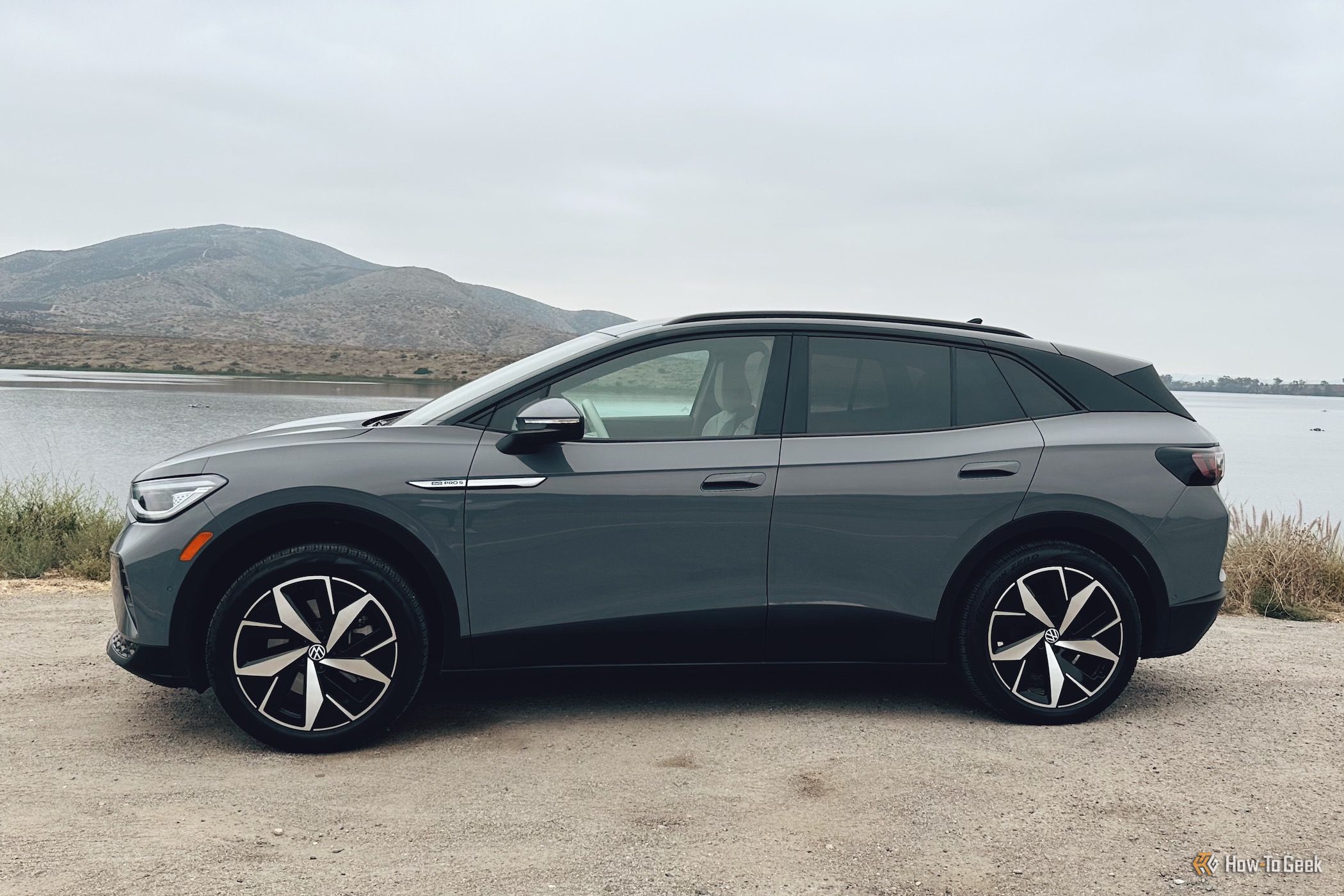
Tyler Hayes / How-To Geek
From a purely cosmetic stance, the ID.4 is ordinary, inside and out. I say that in the most complimentary way possible. Switching from a traditional gas vehicle to an electric one is already a huge transition; adding too much visual upheaval might be a bridge too far for a lot of drivers.
Boring, yes, but also a touch of familiarity in a sea of electric change. To illustrate this point, the charge port is in the same rear right spot a gas tank door would be. This is not always the case with electric vehicles. The non-automatic charge port door even pops open with a push, the same way a gas tank door would.
Unfortunately, there is no frunk, or front trunk. Another way the ID.4 is more traditional than not. If you’re coming from a traditional vehicle you won’t miss the extra space, but any current EV owner probably will as a lot of cars do offer some additional storage under the hood.
The LED projector headlights with AFS were great at night, providing plenty of visibility. But even during the day, they make a (minor) statement as they swivel and move when you approach the car. That can either be neat or a bit creepy. My middle-grade daughter was obsessed with them once she noticed the movements.
Interior Design: Simple, Yet Comfortable
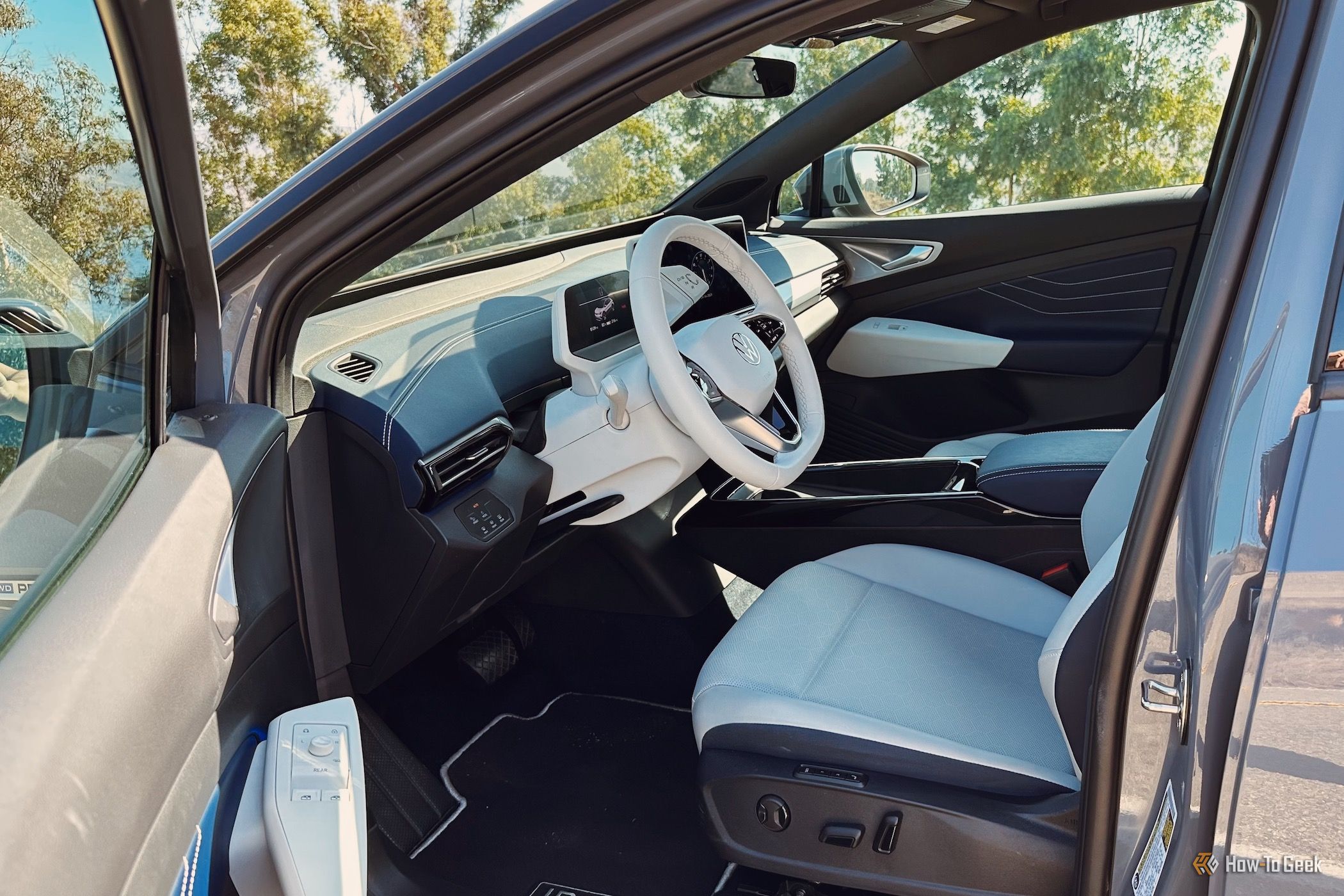
Tyler Hayes / How-To Geek
The first noticeable things inside the AWD Pro S ID.4 are the center console screen and driver gauge display. Both of these jettison up from the dashboard in a way that provides some personality, even though they’re just regular screens. The 12-inch center display is a touchscreen, while the driver one is not.
I wish more information was programmable to display on the driver’s display, but mostly, it’s used for speed, battery life, and directions. Because of the way the big center display is angled, the driver screen almost felt unnecessary, but I didn’t mind its traditional approach. It wasn’t bothersome.
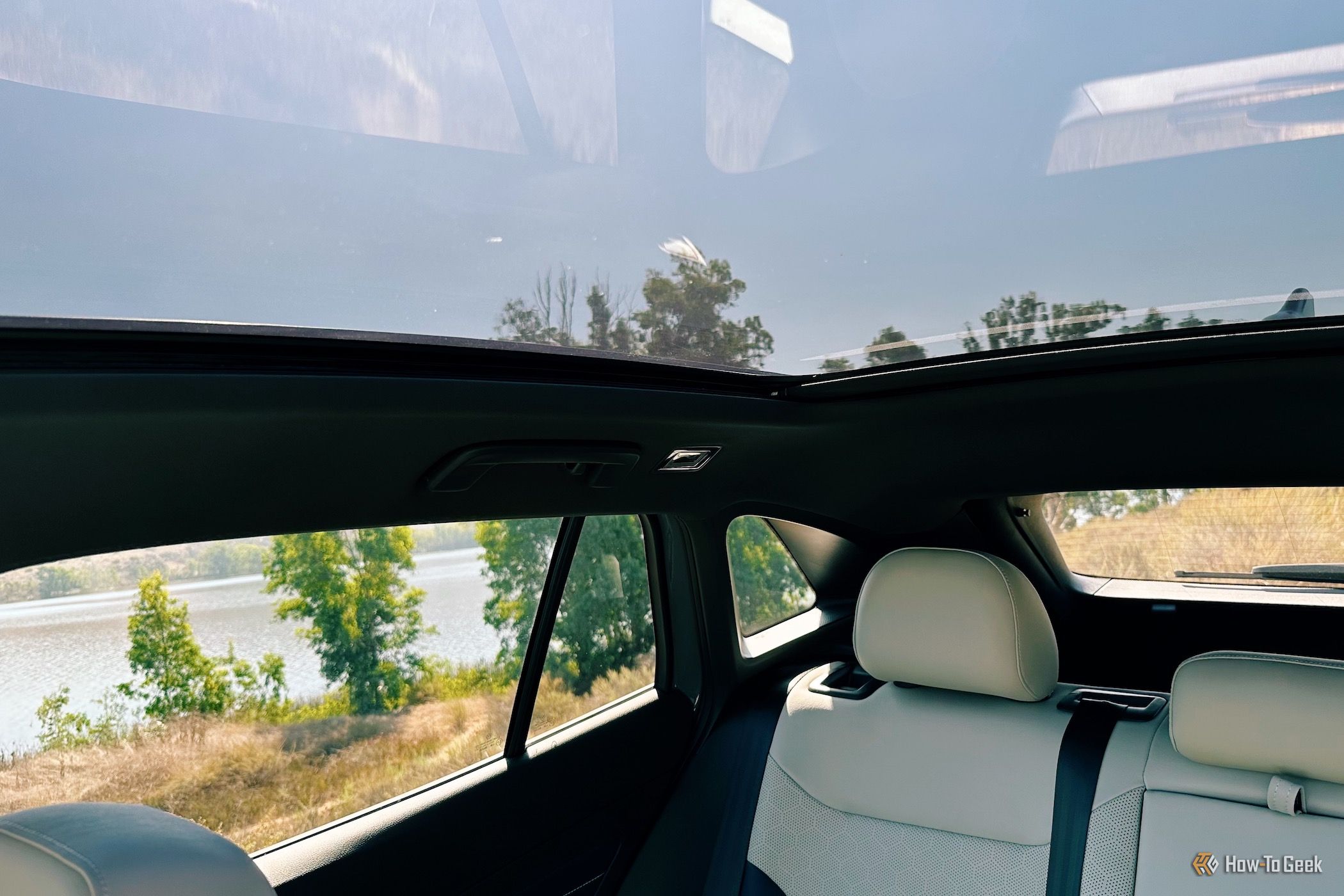
Tyler Hayes / How-To Geek
The glass panoramic roof has an electronic shade to help with heat from the sun.
Coming from a Tesla Model Y, the minimalism of the interior felt immediately familiar. I suppose the ID.4 lacked the amount of knobs and buttons a lot of people will be used to, but it didn’t feel overly sparse to me compared to Tesla’s approach. The glass roof with an electric sunshade was neat, but not overly advanced. While Tesla’s lack of physical controls relies on a technical software story, nothing inside the ID.4 felt forward-leaning. Even the 12-inch infotainment screen stretched Apple’s CarPlay to the point of being able to see pixel discrepancies along borders and on some icons when I looked closely.
The vehicle’s perforated V-tex leatherette seats were comfortable. They had the right mix of firmness and cushion to them. I appreciated the multiple electronic seat adjustments but wished some ventilation in the seats would have been included. There was a heated steering wheel, but a sunny September kept me from fully appreciating it.
The storage area between the driver and passenger was more limited than it seemed like it needed to be. There was only a single covered area under the armrest to hide junk. The rest of the space was dedicated to two cup holders and a wide open area with two USB-C ports for wired charging. There was a wireless Qi charging spot, but a permanent flap that laid on my phone’s glass screen kept me weary of using it frequently.
My daughter and son were both disappointed that there were no climate controls for rear-seated passengers. They both like to have some level of control over the backseat temperature, but it wasn’t present.
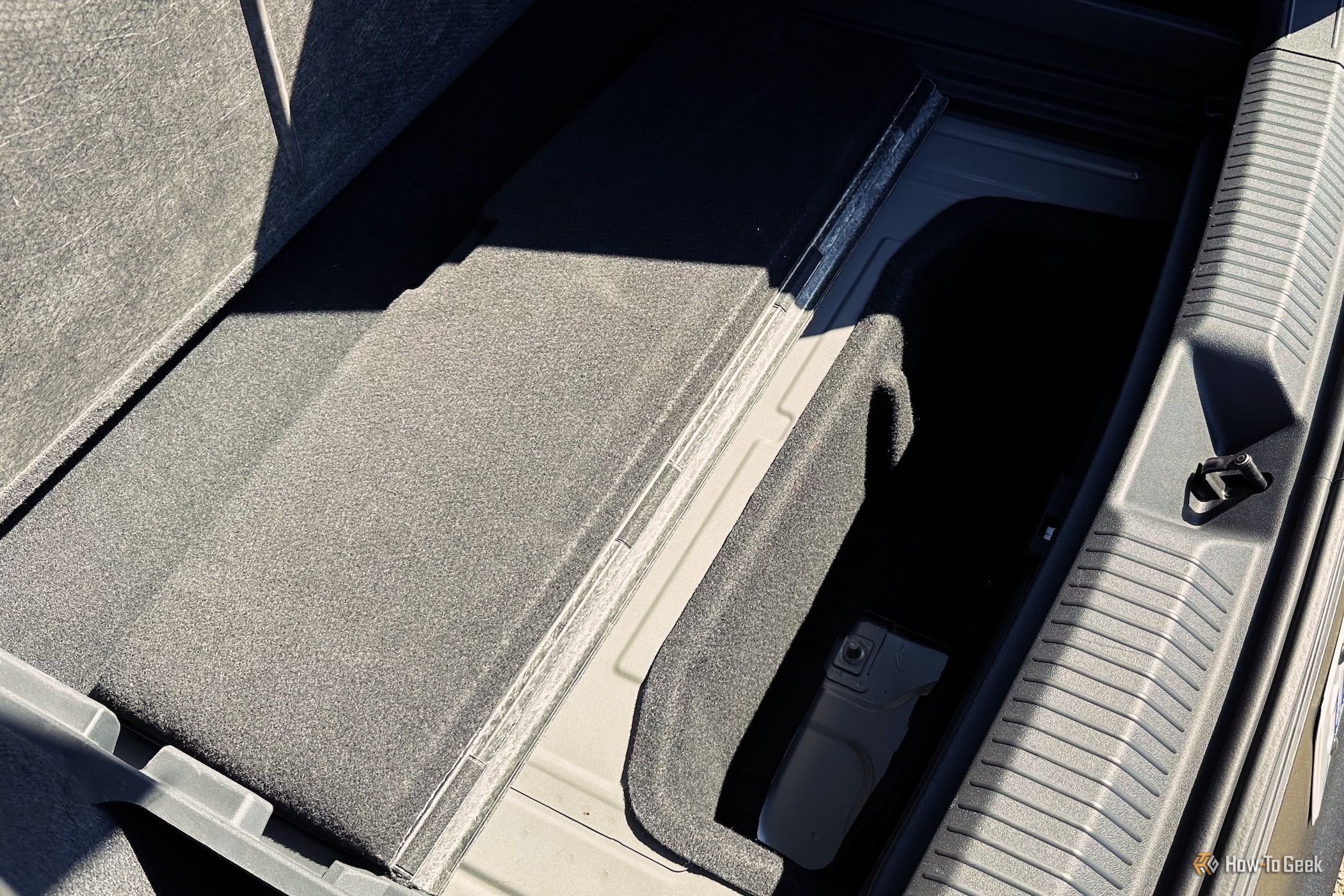
Tyler Hayes / How-To Geek
Different flaps can lift up in the trunk area to reveal a little bit more space for storage.
Inside the trunk area is a false floor that can be lifted to reveal a few extra inches of depth. I didn’t quite understand why the top level was needed—though it can be taken out—with only a minimal difference between the two spaces. There is a deeper storage area further down, but it is rather narrow and doesn’t span the whole trunk area and is rather narrow.
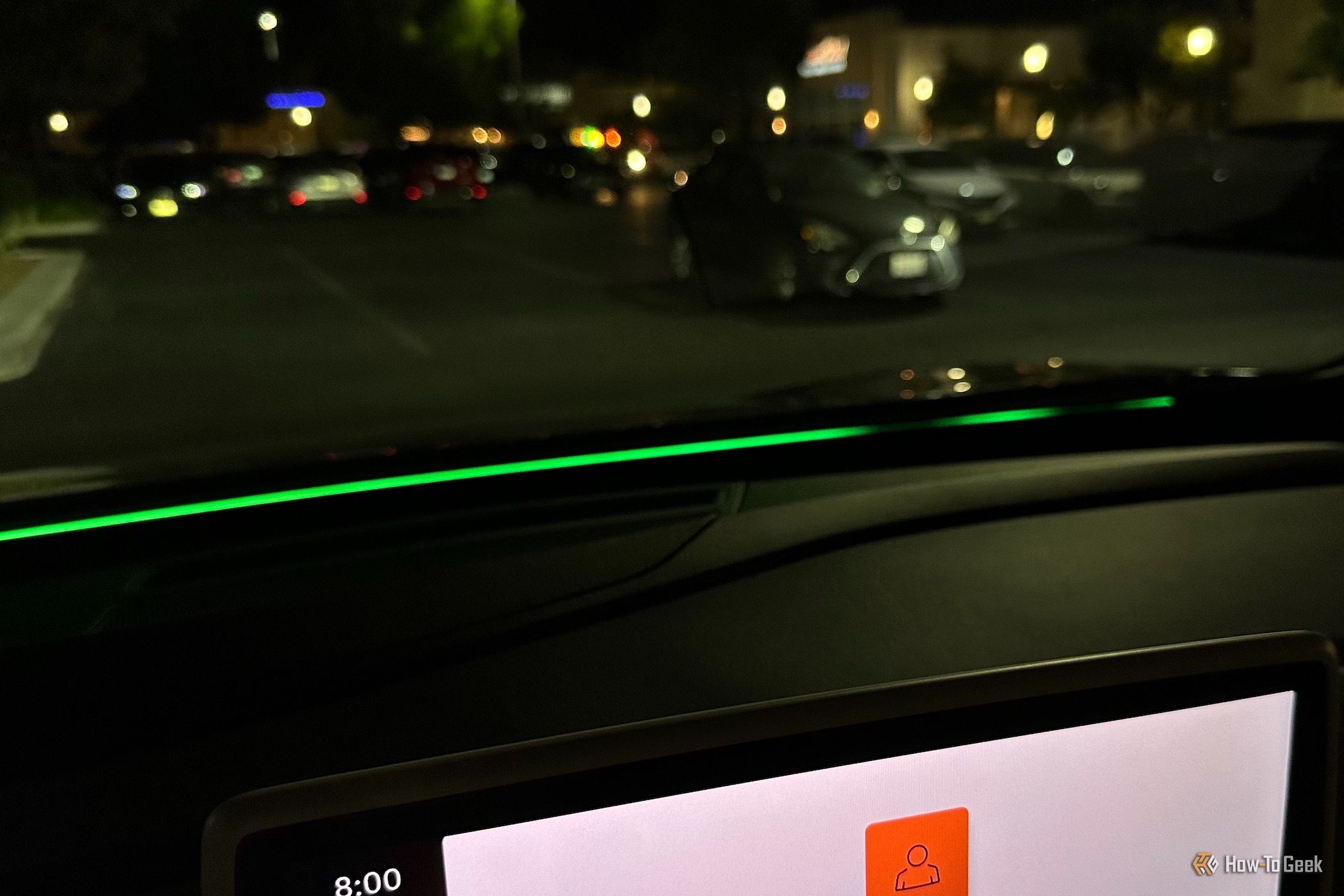
Tyler Hayes / How-To Geek
The light line lights up at different times to indicate different events. Here, the green line shows the charging progress at night.
Along the dash, there’s an illuminated light line. It was less noticeable and useful in practice than some marketing materials make it seem. It was most noticeable to me when it showed a green progress bar while charging at night. But even that seemed redundant.
Range Plus Anxiety
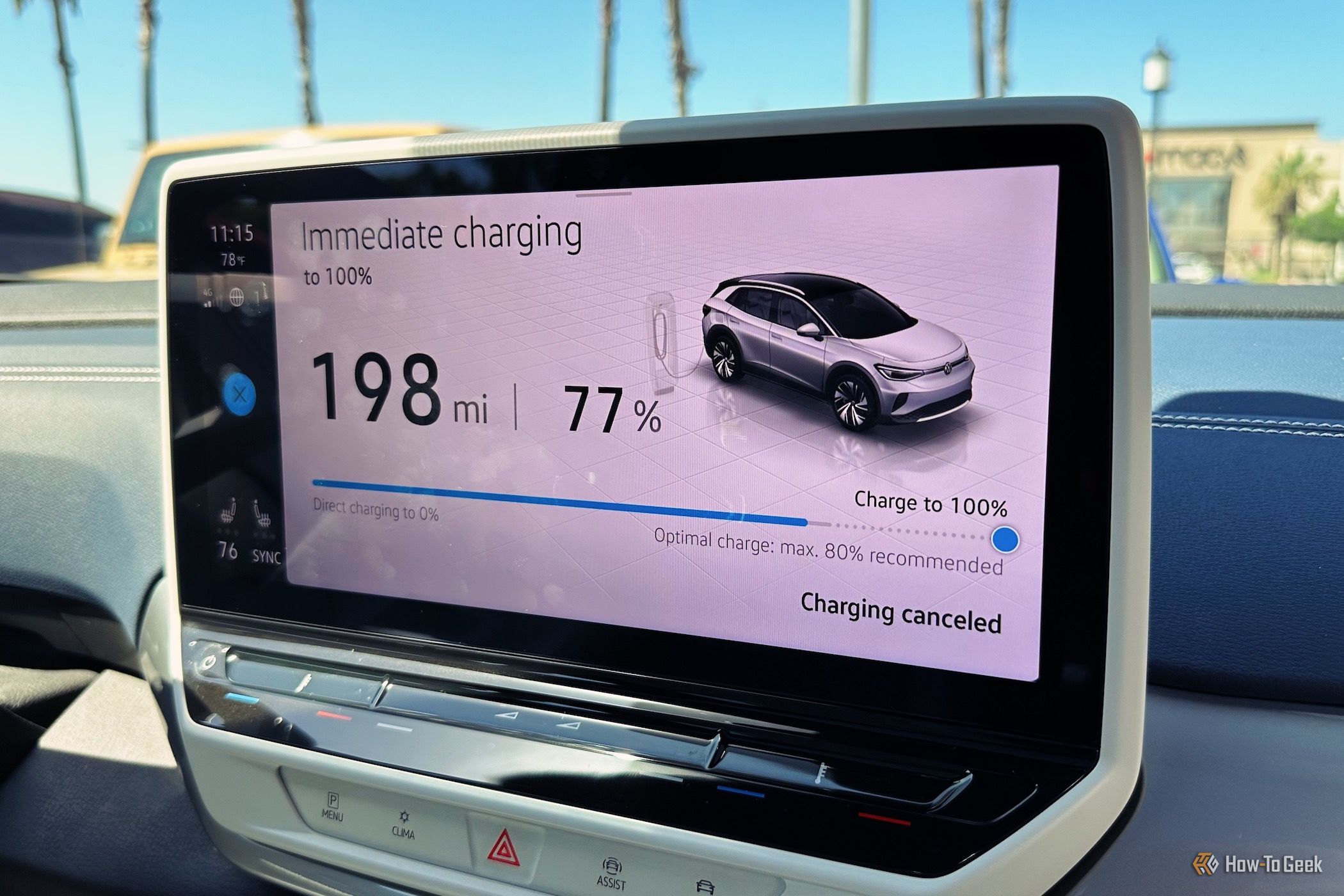
Tyler Hayes / How-To Geek
Charging an electric vehicle should be the primary concern of any potential buyer. You will need to do a little research about available—and compatible—chargers near you or where you travel. Even if you’re buying a Tesla, which has the most robust public charging network in the U.S., you should also have a plan to charge at home overnight.
Unfortunately, the ID.4 got off on the wrong foot in this regard by not including a charging cable with the particular model and trim I reviewed. Hopefully, most people buying this vehicle can work out something with the dealership to get a charge cable prior to driving home. In this case, VW isn’t Apple who can forego putting the charger in the box.
I needed to venture away from home to give the SUV a charge, but my first attempt at public charging didn’t go great. I pulled into a public DC Fast charger stall at a local mall. I opened the charger’s app on my phone, which I have used in the past with other EVs, and authorized payment. I plugged the cable into the ID.4 without issue and then waited as nothing happened.
Was it the charging station or the car that wasn’t working properly? Was it a setting on the car? It wasn’t clear. The app showed the charger working and counted the time it was plugged in. The car showed that charging had been canceled but gave no way to re-start it. After 15 minutes of pushing buttons and scrolling through the car’s interface, I gave up.
I drove around the mall looking for an available, slower, level 2 charger, which produces less power but is free to use in this location. All 10 of those stations were occupied at 10:30 in the morning on a weekday, so I gave up and left without getting an ounce of fresh power.
When I checked the onboard navigation to find another charger around me, it did provide a little assistance when I typed “charger” into its search box. I had to hunt that functionality down, however. The car didn’t automatically or freely offer suggestions that were obvious.
That’s a lot of the story for the ID.4. The car does not go out of its way to be helpful about its electric side. It’s workable but has an unintuitive learning curve. I wish it were more helpful in transitioning owners to the electric lifestyle.
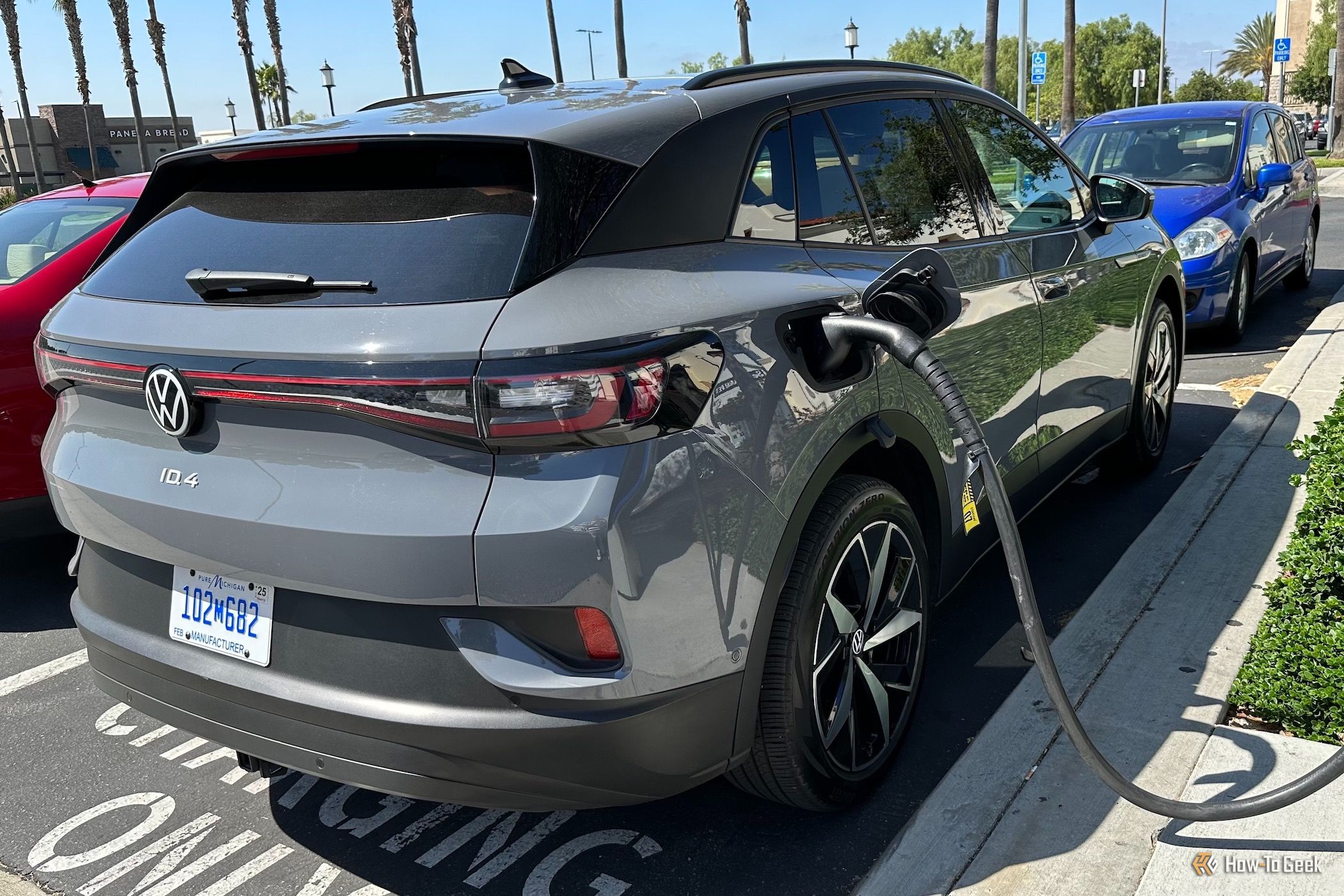
Tyler Hayes / How-To Geek
Eventually, I did find open chargers at various times to boost the battery, but charging the ID.4 in public continually rubbed me the wrong way. It never felt like there was enough information provided to the driver at the right time. For example, the screen that shows while charging doesn’t tell you how many miles it has added since it started charging.
The model I test-drove had an EPA estimated range of 255 miles. In general, that estimate rang true, but I saw this number fluctuate enough to be noticeable on different drives throughout the day. When I would get in or when I would park, the range estimate shown on the screen would sometimes be as much as 10 to 15 miles different from when I had been driving.
VW’s lineup for 2023 ID.4 trims range from 209 to 275 miles depending on battery size and wheel size. I would be hesitant to go below 250 miles of rated range, personally, but it is an option.
Also, a consideration for potential buyers is VW’s deal for ID.4 owners , which gives them unlimited 30-minute charging sessions at Electrify America stalls for three years. I don’t think this deal is a good enough reason to solely pick this car over another one, but it could be helpful, at least to some buyers.
Driving the 2023 ID.4: Coasting Is In
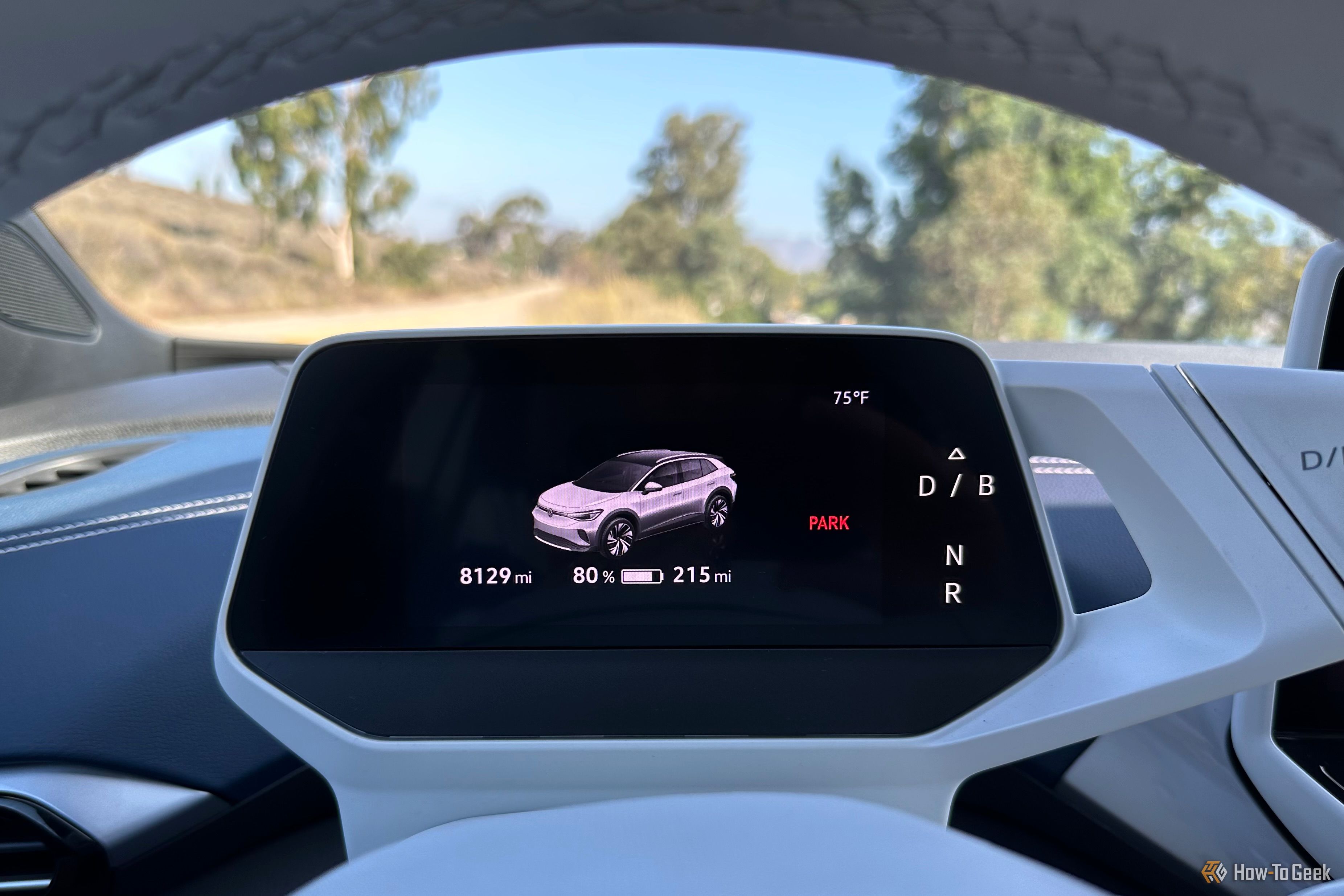
Tyler Hayes / How-To Geek
I’ve been driving electric cars exclusively since 2018, and I was really looking for how the ID.4 felt to plug in as my daily vehicle. Almost no two cars drive the same way, so I was interested in actually feeling the torque and how that translated to getting on the freeway in Southern California. I wanted to see how the vehicle handled the frequent stops of suburban life, like school pickups. The ultimate question being, is the ID.4 a competent all-purpose EV?
In the end, I do think the ID.4 is a competent electric vehicle, but my first drive in it really solidified how much it was only tangentially interested in being like other EVs. As I approached a stop sign and began to let my foot off the accelerator so the regenerative braking could kick in to slow me to a stop, I found myself not slowing at all. I felt like I was driving a gasoline car again. This was very different from the Model Y.
It turns out VW isn’t all that into regen braking , as it has announced. It’s more into the concept of coasting to slow and even out energy usage. The best way to conserve and capture energy in an EV is probably up for debate, but if VW can provide its quoted range, then I don’t really care how it achieves it.
Personally, I do like one-pedal driving, however. I think cars should be inclined to slow quickly and come to a stop by default rather than keep moving. People coming from traditional gasoline cars will probably fall in line with VW’s driving style much quicker than I did.
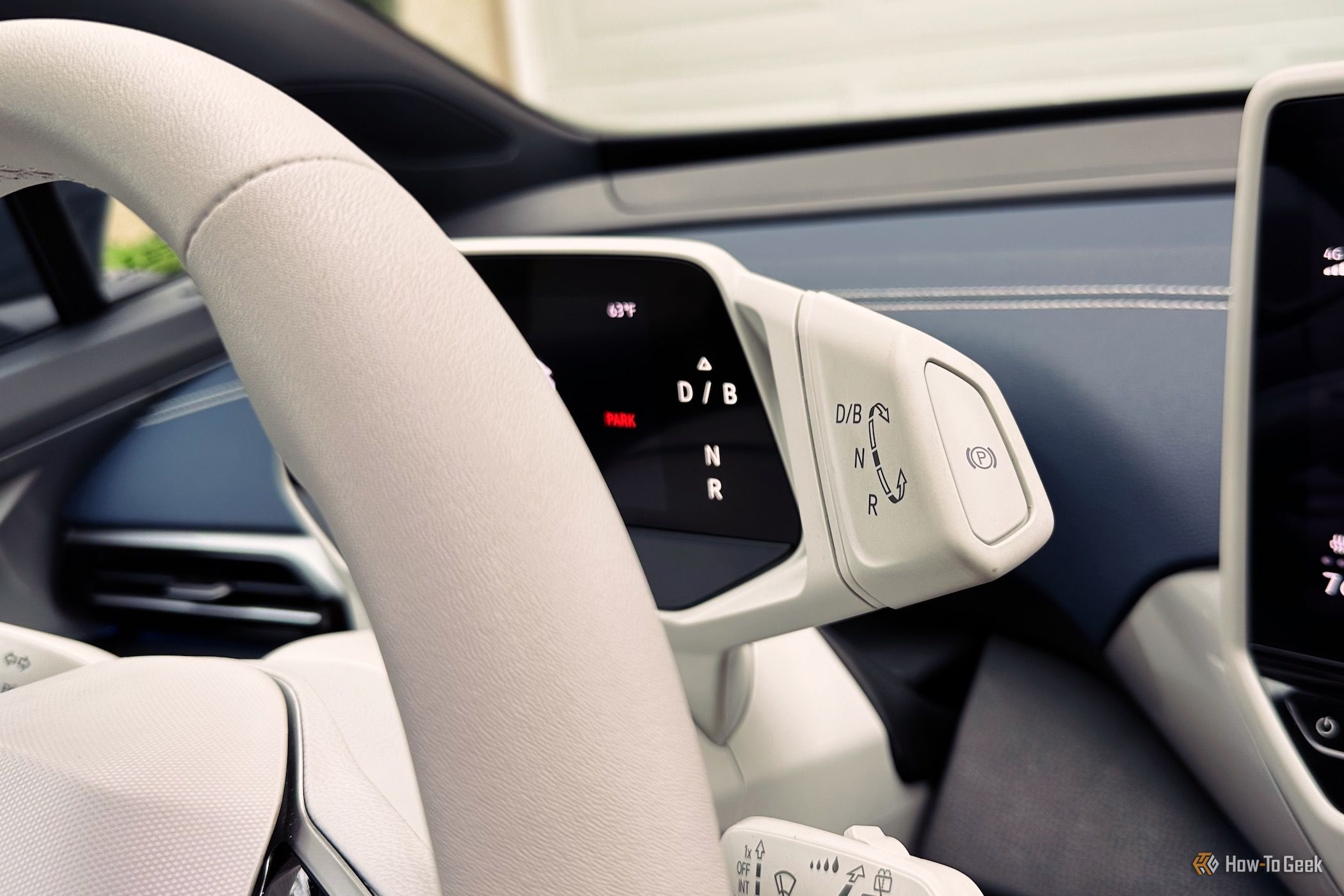
Tyler Hayes / How-To Geek
The knob in the picture can be twisted forward for two different drive modes. It can be twisted back for reverse.
The ID.4’s “B” drive mode does have a bit of regen braking to it, but it’s still very light. I used this driving mode almost exclusively and eventually got familiar with it, but I still missed it slowing aggressively enough to do consistent one-pedal driving. Thankfully, the car does have the option—and I believe it’s on by default—to auto-hold when it comes to a complete stop.
A quick note about the drive mode shifter, which is the angled knob in the picture above. I hated it for the first few two days. It felt awkward to twist forward for drive and backward for reverse. It seems trivial in theory, but it felt harder to master than I expected. Eventually, I did come to find it much easier to use.
In terms of speed, the ID.4 is not as quick as some of the other electric vehicles I’ve driven, but its 5.8-second 0 to 60MPH capability was always peppy. It still had a fun amount of torque. It’s an amazing feeling to effortlessly get up to speed while merging onto a freeway. Ultimately, all I want from a vehicle is for it to be smooth and responsive, and this car delivered those results.
Safety-wise, this car has IQ.Drive features which includes things like adaptive cruise control, lane assist, assisted lane change, traffic sign recognition, and parking assist. All things you would expect from a vehicle at this price. Most of these features weren’t as prominently displayed as I would have expected them to be. One thing that did annoy me in terms of visibility was the rear backup camera. It was so distorted and stretched that it felt much less helpful than other vehicles’ cameras. I also couldn’t find a way to access the backup camera without putting it in reverse as well, which felt like a big omission.
Infotainment and Technology, or a Lack Thereof
Every time I got in the car, a full-screen message would show on the center display, asking which user account was behind the wheel. It was way too aggressive about this information to the point that it would interrupt anything to ask about the user in the driver’s seat.
The best example of this atrocity was at a charging station. I parked, got out of the car and, plugged in the charging cable, came back to the driver’s side to confirm it was getting power, and the screen would be inactive. If I sat down, everything would be obstructed by this full-screen message until I selected a user. If I moved too much in the seat the car might think it needed to ask who was driving again. It was an infuriating experience that didn’t need to happen.
I know why the car was asking about the person driving, because it wanted to configure the settings for different drivers, but it was beyond unhelpful to the point of not allowing basic functions. I would have much preferred to manually tap a button on the screen to switch driver profiles rather than have a full-screen window block all information.
Close
Thank goodness for Apple’s CarPlay inclusion because VW’s general infotainment options were lacking. Even using the wireless CarPlay, however, could be frustrating on short trips with needing to confirm with multiple button taps—or wait for it to eventually activate on its own.
As lackluster as the infotainment was, the myVW mobile app—available for iPhone and Android —was worse. The app offers service reminders, service scheduling, and roadside assistance requests, all of which could be helpful on a (hopefully) very infrequent basis. I didn’t need to use any of those things.
What I did want to use, things like remote climate control and remote battery charging, were terrible. The app couldn’t even lock or unlock the car. There was no way to roll up the windows or close the trunk. The app’s information was often outdated, too, so I had to pull-to-refresh all the time to confirm the app was up-to-date. The app did just enough to be a tease. It did know how to send notifications, though. I would pull into my driveway, park, and then immediately receive a notification that the doors were unlocked, even before I was fully out of the car.
When VW says the app can do remote battery charging, it means there are buttons to start and stop it. That’s it. There’s no way to adjust the speed of charging or anything like that. It was the same limitations for remote climate control. I could turn it on and supposedly set the temperature, but that part never responded for me. On top of everything, the app was slow and always seemed to have connectivity issues, no matter where the vehicle was parked.
Tesla’s app, in comparison, is an embarrassment of riches. Almost anything that can be done in the car itself can also be done remotely from the app. Honk, crack the windows, make fart sounds, turn on a specific seat heater, set a departure time, it’s all there. With premium connectivity, the Tesla app can even stream a live view of its cameras.
Should You Buy the 2023 VVW ID.4?
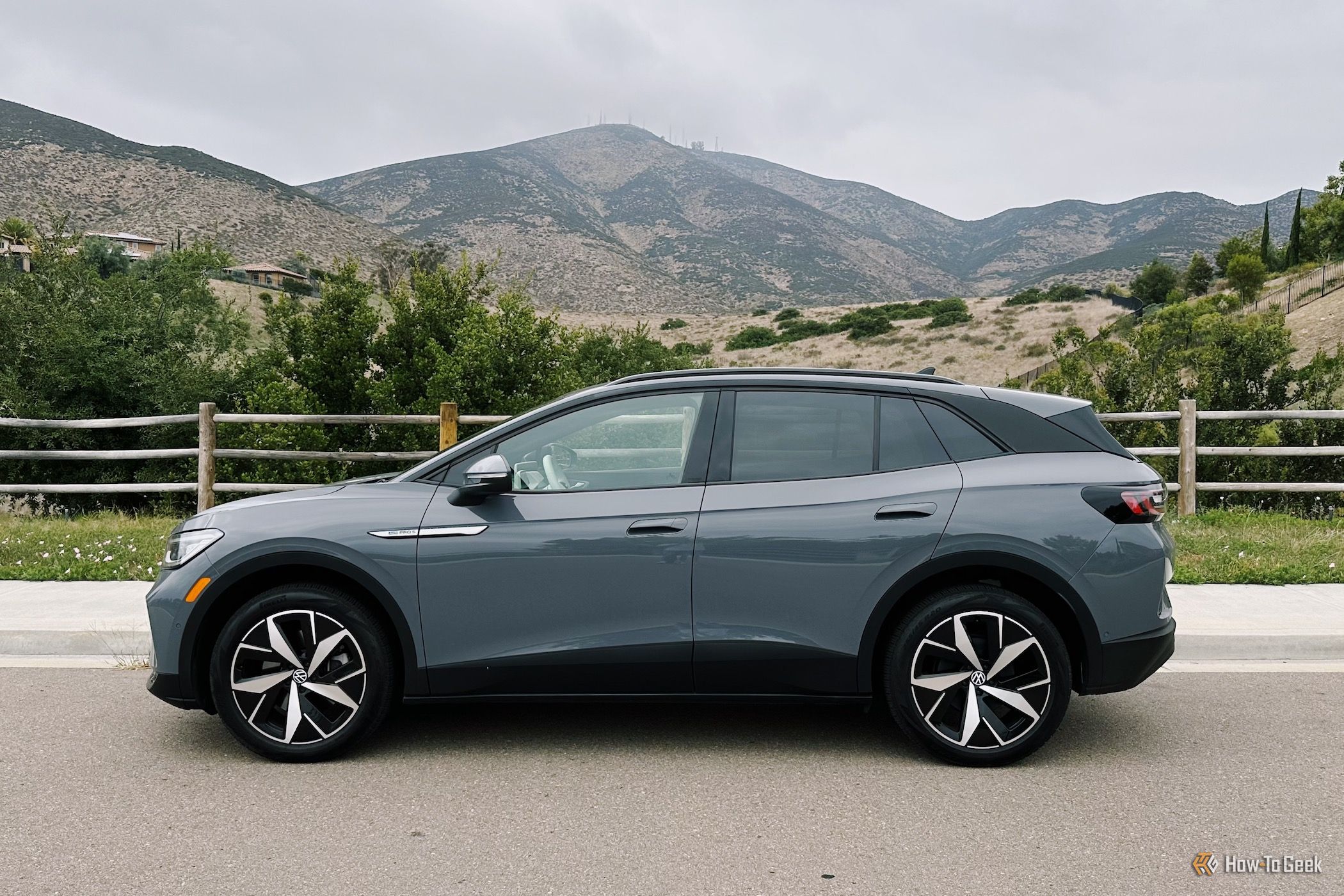
Tyler Hayes / How-To Geek
There are two considerations when figuring out whether this is a vehicle worth recommending. The first is whether the 2023 VW ID.4 is worth driving at all. The second is how it compares to other EV choices. I think it performed well enough as a 5-seat SUV to be part of the EV conversation. It drove well. It is not at the peak of the tech curve, but that’s probably fine for a lot of people. The charging story is also certainly a weak part, but as long as you get a home charger set up, this vehicle should be more than sufficient for daily commuting. Extended day trips and other travel could present more considerations, but that’s dependent on each person’s location and travel plans.
As for how the vehicle compares to other driving options, this $52,795 AWD ID.4 Pro S wouldn’t be my first choice for an EV. The elephant in the room is Tesla’s Model Y. It’s a direct competitor in size and price that has more storage and technical advantages. After driving a Model Y for several years I would find it hard to give it up to move to the ID.4.
At this moment in 2023, my decision to pick a 2023 ID.4 would revolve around getting an excellent deal. The most economical version is the ID.4 Pro RWD, with a range of 275 miles and a starting of $43,995. That trim, paired with a federal tax rebate could provide a solid value and a great way for reluctant gasoline car owners to switch to electric power.

2023 Volkswagen ID.4
7/ 10
The all-electric 2023 ID.4 is an SUV through and through, offering a spacious, modern cabin built for drivers and passengers alike along with sporty, streamlined looks.
Also read:
- [New] 2024 Approved Enhance Content Reach and Impact - Social Blade's Role in YouTube Analytics
- [New] Lose Yourself to Laughter Best 10 Jokes for 2024
- [New] Revolutionize Your Augmented Reality Graphics Using Custom LUTs for 2024
- [Updated] In 2024, Creating Stunning 3D Text with PS
- [Updated] In 2024, Step-by-Step Mac Techniques to Edit SRT Files
- 2024 Approved Hiding YouTube Playback Tips for iOS and Android
- 2024 Approved The Secret Sauce for a Viral TikTok Unboxer Masterpiece
- Cultivation of a Connected Crowd The Subscriber Surge Strategy
- How To Repair Apple iPhone 13 Pro Max iOS System Issues? | Dr.fone
- How To Transfer WhatsApp From Apple iPhone 6s Plus to other iPhone 13 Pro Max devices? | Dr.fone
- Melodies for Success Best Top 10 Music for Podcast Startups
- Repair Video Tool - Repair all your damaged video files of Poco M6 Pro 5G
- Repair Video Tool - Repair all your damaged video files of Vivo Y200e 5G on Windows
- Samsung Galaxy A05 can't play MP4 video files
- Simple ways to get recent calls back from Itel P40
- Simple ways to get recent calls back from ZTE Nubia Flip 5G
- Solve Crashes in V-Rising Game on PC with These Simple Steps
- Undelete lost contacts from 150 (2023).
- Update your hardware drivers with Device Manager on Windows 11 & 10
- Title: Overcoming Electric Vehicle Resistance: The 2023 VW ID.4 Comprehensive Review
- Author: Ian
- Created at : 2025-02-17 21:39:41
- Updated at : 2025-02-19 19:50:40
- Link: https://techidaily.com/overcoming-electric-vehicle-resistance-the-2023-vw-id4-comprehensive-review/
- License: This work is licensed under CC BY-NC-SA 4.0.